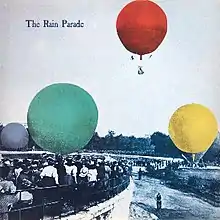| Emergency Third Rail Power Trip | ||||
|---|---|---|---|---|
 | ||||
| Studio album by | ||||
| Released | 1983 | |||
| Recorded | February – March 1983 | |||
| Studio | Contour Studios, Los Angeles, California | |||
| Genre | Paisley Underground, psychedelic pop, jangle pop | |||
| Length | 41:51 | |||
| Label | Restless | |||
| Producer | David Roback; Ethan James on "Saturday's Asylum" | |||
| Rain Parade chronology | ||||
| ||||
Emergency Third Rail Power Trip is the debut album by American rock band Rain Parade, released in 1983. It is one of the most prominent records in the Paisley Underground movement of the 1980s.
Critical reception
| Review scores | |
|---|---|
| Source | Rating |
| AllMusic | |
| Mojo | |
| Q | |
| Record Mirror | |
| Uncut | 8/10[5] |
| The Village Voice | C+[6] |
In a contemporary review for The Village Voice, music critic Robert Christgau felt that the band imitates "dumb" music from the psychedelic era, specifically "the wimpy singing, wispy tunes, unsure drumming, repetitive guitar effects, and naïve world view of, oh, Kaleidoscope, Morning Glory, Aum."[6]
However, AllMusic's Denise Sullivan would later state that the band was "clearly way ahead of their time," adding that "it would take years before sleepy music ... would catch on."[1] As a result, the "traditional, gentle psychedelic pop" of this record "sounds no more made in the '80s than in the '60s or '90s."[1] In his 2003 book Turn On Your Mind: Four Decades of Great Psychedelic Rock, critic Jim DeRogatis stated, "Emergency Third Rail Power Trip is not only the best album from any of the Paisley Underground bands, it ranks with the best psychedelic rock efforts from any era", with uplifting melodies offset by themes that were "dark and introspective."[7] DeRogatis added:
Songs such as "What's She Done to Your Mind," "Kaleidoscope," and "Look at Merri" showcase Piucci and the Robacks' ethereal vocals, Eddie Kalwa's precise drumming, Matt Piucci's colorful sitar, Will Glenn's violin and keyboard accents, and an intricate, chiming, but droney two-guitar attack that picks up where the Byrds left off with "Eight Miles High."[7]
Musician and critic Scott Miller, in his 2010 book Music: What Happened?, cited "1 Hour 1⁄2 Ago" as one of 1983's best songs, calling the Rain Parade "core practitioners" of the Paisley Underground movement, with this album being "probably the most certifiably trippy of the branded projects."[8]
Track listing
- "Talking in My Sleep" (Matt Piucci, David Roback) – 3:49
- "This Can't Be Today" (Steven Roback, Matt Piucci) – 4:36
- "I Look Around" (David Roback) – 3:07
- "1 Hour 1⁄2 Ago" (Steven Roback, David Roback) – 4:14
- "Carolyn's Song" (David Roback) – 4:05
- "What She's Done to Your Mind" (Matt Piucci, David Roback) – 2:56
- "Look at Merri" (Matt Piucci, David Roback, Steven Roback) – 6:34
- "Saturday's Asylum" (Steven Roback, Matt Piucci) – 3:45
- "Kaleidoscope" (Steven Roback) – 5:35
- "Look Both Ways" (Matt Piucci) – 3:10
Personnel
- Rain Parade
- David Roback – vocals, guitar, percussion
- Matt Piucci – vocals, guitar, sitar, harmonica
- Steven Roback – vocals, bass
- Will Glenn – keyboards, violin
- Eddie Kalwa – drums
References
- 1 2 3 Sullivan, Denise. "Emergency Third Rail Power Trip – Rain Parade". AllMusic. Retrieved March 15, 2020.
- ↑ Male, Andrew (December 2019). "The Rain Parade: Emergency Third Rail Power Trip". Mojo. No. 313. London. p. 102.
- ↑ "Rain Parade: Emergency Third Rail Power Trip". Q. No. 68. London. May 1992. p. 98.
- ↑ Gardner, Mike (September 8, 1984). "The Rain Parade: Emergency Third Rail Power Trip". Record Mirror. London. p. 18.
- ↑ Bonner, Michael (October 2013). "The Prettiest Star...". Uncut. No. 197. London. p. 26.
- 1 2 Christgau, Robert (June 12, 1984). "Christgau's Consumer Guide: Turkey Shoot". The Village Voice. New York. Retrieved August 22, 2013.
- 1 2 DeRogatis, Jim (2003). Turn On Your Mind: Four Decades of Great Psychedelic Rock. Hal Leonard Corporation. p. 362. ISBN 9780634055485.
- ↑ Miller, Scott (2010). Music: What Happened?. 125 Records. p. 117. ISBN 9780615381961.